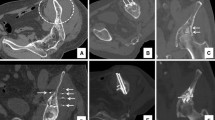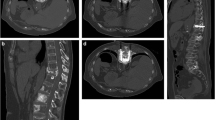Abstract
Purpose
Screw fixation (osteosynthesis) can be performed percutaneously by interventional radiologists. We report our experience in cancer patients.
Material/methods
We retrospectively reviewed all cases of percutaneous osteosynthesis (PO) of the pelvic ring and proximal femur performed in our hospital. PO were performed for fracture palliation or for osteolytic metastases consolidation. Screws were inserted under CT- or cone-beam CT- guidance and general anaesthesia. Patients were followed-up with pelvic-CT and medical consultation at 1 month, then every 3 months. For fractures, the goal was pain palliation and for osteolytic metastases, pathologic fracture prevention.
Results
Between February 2010 and August 2014, 64 cancer patients were treated with PO. Twenty-one patients had PO alone for 33 painful fractures (13 bone-insufficiency, 20 pathologic fractures). The pain was significantly improved at 1 month (VAS score = 20/100 vs. 80/100). In addition, 43 cancer patients were preventively consolidated using PO plus cementoplasty for 45 impending pathologic fractures (10 iliac crests, 35 proximal femurs). For the iliac crests, no fracture occurred (median-FU = 75 days). For the proximal femurs, 2 pathological fractures occurred (fracture rate = 5.7 %, median-FU = 205 days).
Conclusion
PO is a new tool in the therapeutic arsenal of interventional radiologists for bone pain management.
Key Points
• Screw fixation (osteosynthesis) can be performed percutaneously by interventional radiologists.
• CT- or CBCT-guidance results in high technical success rates for screw placement.
• This minimally invasive technique avoids extensive surgical exposure in bone cancer patients.
• Osteosynthesis provides pain relief for bone-insufficiency fractures and for pathologic fractures.
• Osteosynthesis plus cementoplasty provide prophylactic consolidation of impending pathological fractures.






Similar content being viewed by others
References
Winkelhagen A, van den Bekerom MPJ, Bolhuis HW, Hogervorst M (2012) Preliminary results of cannulated screw fixation for isolated pubic ramus fractures. Strat Traum Limb Recon 7:87–91
Mosheiff R, Liebergall M (2002) Maneuvering the retrograde medullary screw in pubic ramus fractures. J Orthop Trauma 16:594–596
Routt ML Jr, Simonian PT, Grujic L (1995) The retrograde medullary superior pubic ramus screw for the treatment of anterior pelvic ring disruptions: a new technique. J Orthop Trauma 9:35–44
Asnis SE, Wanek-Sgaglione L (1994) Intracapsular fractures of the femoral neck. Results of cannulated screw fixation. J Bone Joint Surg Am 76:1793–1803
Reuther G, Rohner U, Will T, Dehne I, Petereit U. CT-guided screw fixation of vertical sacral fractures in local anaesthesia using a standard CT. Fortschr Röntgenstr. doi:10.1055/s-0034-1366605
Strobl FF, Haeussler SM, Paprottka PM, Hoffmann RT, Pieske O, Reiser MF et al (2014) Technical and clinical outcome of percutaneous CT fluoroscopy-guided screw placement in unstable injuries of the posterior pelvic ring. Skelet Radiol 43:1093–1100
Tsoumakidou G, Borensztein M, Zini C, Garnon J, Gangi A. Postablation insufficiency fracture of the iliac crest: management by percutaneous screw fixation. Cardiovasc Intervent Radiol. doi:10.1007/s00270-013-0781-1
Amoretti N, Huwart L, Hauger O et al (2013) Percutaneous Screw Fixation of Acetabular Roof Fractures by Radiologists Under CT and Fluoroscopy Guidance. AJR 200:447–450
Amoretti N, Hovorka I, Marcy PY, Hauger O, Amoretti ME, Lesbats V et al (2009) Computed axial tomography-guided fixation of sacroiliac joint disruption: safety, outcomes, and results at 3-year follow-up. Cardiovasc Intervent Radiol 32:1227–1234
Deschamps F, de Baere T (2012) Cementoplasty of bone metastases. Diagn Interv Imaging 93:685–689
Gay SB, Sistrom C, Wang GJ et al (1992) Percutaneous screw fixation of acetabular fractures with CT guidance: preliminary results of a new technique. AJR 158:819–822
Winkelhagen J, van den Bekerom MPJ, Bolhuis HW, Hogervorst M (2012) Preliminary results of cannulated screw fixation for isolated pubic ramus fractures. Strat Traum Limb Recon 7:87–91
Selvan VT, Oakley MJ, Rangan A et al (2004) Optimum configuration of cannulated hip screws for the fixation of intra- capsular hip fractures: a biomechanical study. Injury 35:136–141
Yih-Shiunn L, Chien-Rae H, Wen-Yun L (2007) Surgical treatment of undisplaced femoral neck fractures in the elderly. Int Orthop (SICOT) 31:677–682
Deschamps F, Farouil G, Hakime A, Barah A, Guiu B, Teriitehau C et al (2012) Cementoplasty of metastases of the proximal femur: is it a safe palliative option? J Vasc Interv Radiol 23:1311–1316
Mirels H (1989) Metastatic disease in long bones. A proposed scoring system for diagnosing impending pathologic fractures. Clin Orthop Relat Res 249:256–264
Deschamps F, Farouil G, Hakime A, Teriitehau C, Barah A, de Baere T (2011) Percutaneous stabilization of impending pathological fracture of the proximal femur. Cardiovasc Intervent Radiol 35:1428–1432
Van der Linden YM, Dijkstra PD, Kroon HM et al (2004) Comparative analysis of risk factors for pathological fracture with femoral metastases. J Bone Joint Surg (Br) 4:566–573
Schmeler KM, Jhingran A, Iyer RB, Sun CC, Eifel PJ, Soliman PT et al (2010) Pelvic Fractures After Radiotherapy for Cervical Cancer. Cancer 116:625–630
Uezono H, Tsujino K, Moriki K, Nagano F, Ota Y, Sasaki R et al (2013) Pelvic insufficiency fracture after definitive radiotherapy for uterine cervical cancer: retrospective analysis of risk factors. J Radiat Res 54:1102–1110
Zwingmann J, Hauschild O, Bode G, Sudkamp NP, Schmal H (2013) Malposition and revision rates of different imaging modalities for percutaneous iliosacral screw fixation following pelvic fractures: a systematic review and meta‐analysis. Arch Orthop Trauma Surg 133:1257–1265
Coste C, Asloum Y, Marcheix PS, Dijoux P, Charissoux JL, Mabit C (2013) Percutaneous iliosacral screw fixation in unstable pelvic ring lesions: The interest of O-ARM CT-guided navigation. Orthop Traumatol Surg Res 99S:S273–S278
Frey ME, DePalma MJ, Cifu DX, Bhagia SM, Daitch JS (2007) Efficacy and safety of percutaneous sacroplasty for painful osteoporotic sacral insufficiency fractures: a prospective, multicenter trial. Spine 32:1635–1640
Beall DP, D’Souza SL, Costello RF et al (2007) Percutaneous augmentation of the superior pubic ramus with polymethyl methacrylate: treatment of acute traumatic and chronic insufficiency fractures. Skelet Radiol 36:979–983
Marcy PY, Palussière J, Descamps B, Magné N, Bondiau PY, Ciais C et al (2000) Percutaneous cementoplasty for pelvic bone metastasis. Support Care Cancer 8:500–503
Fischer S, Vogl TJ, Marzi I, Zangos S, Wichmann JL, Scholtz JE et al (2015) Percutaneous cannulated screw fixation of sacral fractures and sacroiliac joint disruptions with CT-controlled guidewires performed by interventionalists: single center experience in treating posterior pelvic instability. Eur J Radiol 84:290–294
Acknowledgments
The authors thank Lorna Saint-Ange for editing this manuscript.
The scientific guarantor of this publication is Pr Thierry de Baere. The authors of this manuscript declare no relationships with any companies whose products or services may be related to the subject matter of the article. The authors state that this work has not received any funding. No complex statistical methods were necessary for this paper. Institutional review board approval was obtained. Written informed consent was waived by the institutional review board. The first 12 patients of this series have been previously reported in a published paper: "Percutaneous Stabilization of Impending Pathological Fracture of the Proximal Femur. Deschamps F, Farouil G, Hakime A, Teriitehau C, Barah A, de Baere T. Cardiovasc Intervent Radiol. 2011 Dec 28"
Methodology: retrospective, observational/performed at one institution.
Author information
Authors and Affiliations
Corresponding author
Rights and permissions
About this article
Cite this article
Deschamps, F., de Baere, T., Hakime, A. et al. Percutaneous osteosynthesis in the pelvis in cancer patients. Eur Radiol 26, 1631–1639 (2016). https://doi.org/10.1007/s00330-015-3971-1
Received:
Revised:
Accepted:
Published:
Issue Date:
DOI: https://doi.org/10.1007/s00330-015-3971-1




